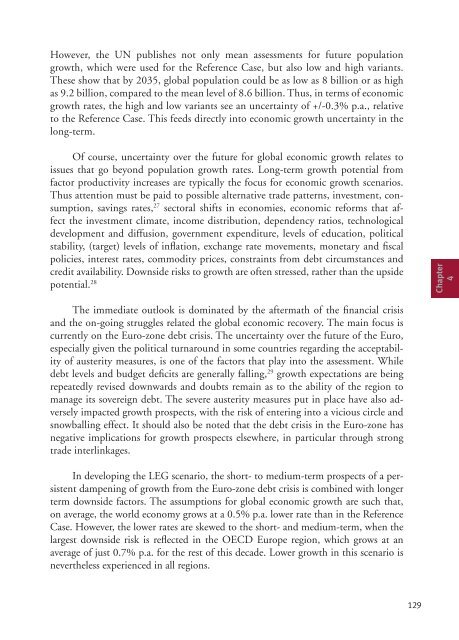World Oil Outlook - Opec
World Oil Outlook - Opec
World Oil Outlook - Opec
- TAGS
- world
- outlook
- opec
- www.opec.org
Create successful ePaper yourself
Turn your PDF publications into a flip-book with our unique Google optimized e-Paper software.
However, the UN publishes not only mean assessments for future population<br />
growth, which were used for the Reference Case, but also low and high variants.<br />
These show that by 2035, global population could be as low as 8 billion or as high<br />
as 9.2 billion, compared to the mean level of 8.6 billion. Thus, in terms of economic<br />
growth rates, the high and low variants see an uncertainty of +/-0.3% p.a., relative<br />
to the Reference Case. This feeds directly into economic growth uncertainty in the<br />
long-term.<br />
Of course, uncertainty over the future for global economic growth relates to<br />
issues that go beyond population growth rates. Long-term growth potential from<br />
factor productivity increases are typically the focus for economic growth scenarios.<br />
Thus attention must be paid to possible alternative trade patterns, investment, consumption,<br />
savings rates, 27 sectoral shifts in economies, economic reforms that affect<br />
the investment climate, income distribution, dependency ratios, technological<br />
development and diffusion, government expenditure, levels of education, political<br />
stability, (target) levels of inflation, exchange rate movements, monetary and fiscal<br />
policies, interest rates, commodity prices, constraints from debt circumstances and<br />
credit availability. Downside risks to growth are often stressed, rather than the upside<br />
potential. 28<br />
The immediate outlook is dominated by the aftermath of the financial crisis<br />
and the on-going struggles related the global economic recovery. The main focus is<br />
currently on the Euro-zone debt crisis. The uncertainty over the future of the Euro,<br />
especially given the political turnaround in some countries regarding the acceptability<br />
of austerity measures, is one of the factors that play into the assessment. While<br />
debt levels and budget deficits are generally falling, 29 growth expectations are being<br />
repeatedly revised downwards and doubts remain as to the ability of the region to<br />
manage its sovereign debt. The severe austerity measures put in place have also adversely<br />
impacted growth prospects, with the risk of entering into a vicious circle and<br />
snowballing effect. It should also be noted that the debt crisis in the Euro-zone has<br />
negative implications for growth prospects elsewhere, in particular through strong<br />
trade interlinkages.<br />
In developing the LEG scenario, the short- to medium-term prospects of a persistent<br />
dampening of growth from the Euro-zone debt crisis is combined with longer<br />
term downside factors. The assumptions for global economic growth are such that,<br />
on average, the world economy grows at a 0.5% p.a. lower rate than in the Reference<br />
Case. However, the lower rates are skewed to the short- and medium-term, when the<br />
largest downside risk is reflected in the OECD Europe region, which grows at an<br />
average of just 0.7% p.a. for the rest of this decade. Lower growth in this scenario is<br />
nevertheless experienced in all regions.<br />
129<br />
Chapter<br />
4
















